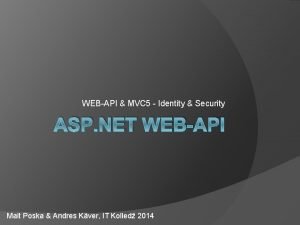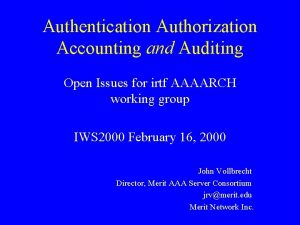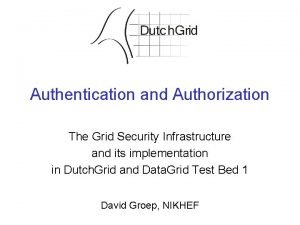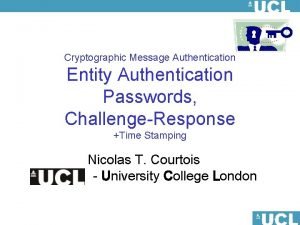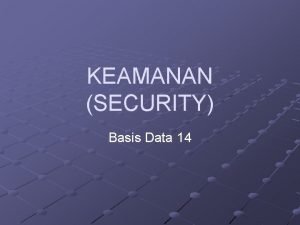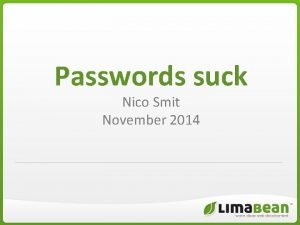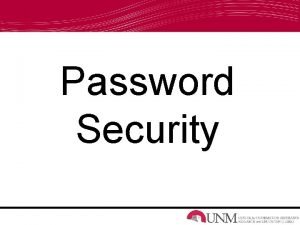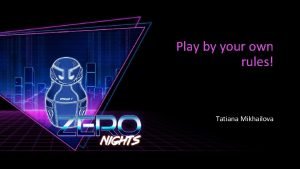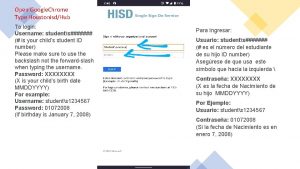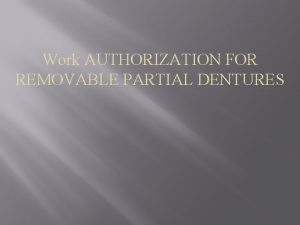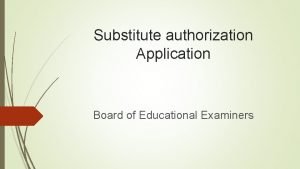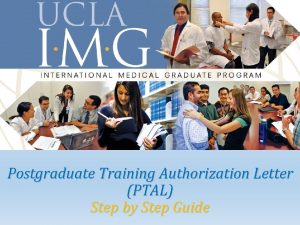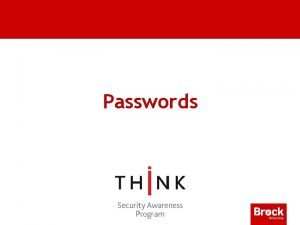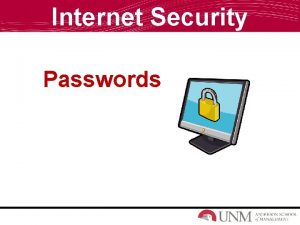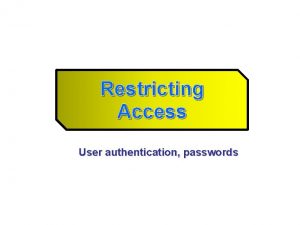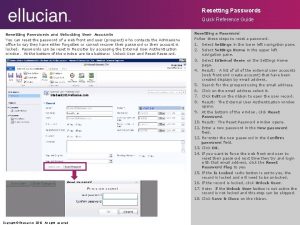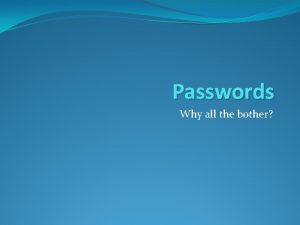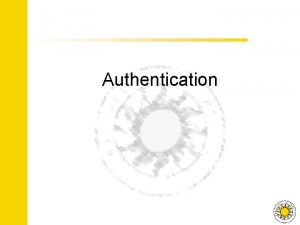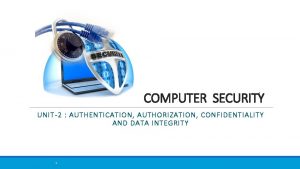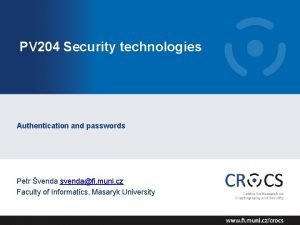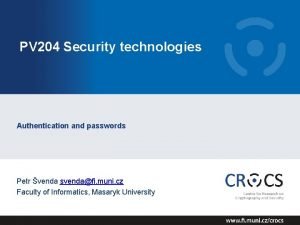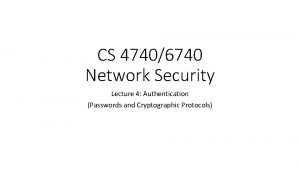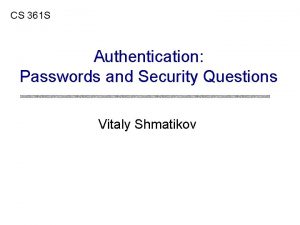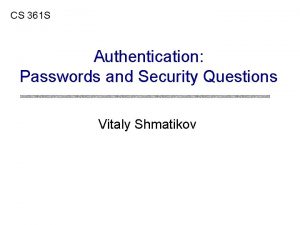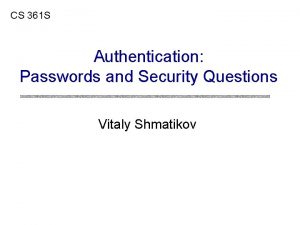Computer Security Passwords Authentication vs Authorization Authentication n


















- Slides: 18

Computer Security Passwords

Authentication vs. Authorization Authentication n n Proving you are who you say you are Tools: passwords, biometrics Authorization n n Given who you say you are, do you have privilege to do a particular action / affect a particular object? Tools: access control lists, privileges

Password Security/Policy Issues Length Required Characters (Letters, Letters plus Digits plus Special Chars, etc. Prohibited Constructs (e. g. Dictionary Words) User Changeability (Require/Prevent User From Changing) n How often? How password remembered (memory, written, on system, etc. )

Classic Techniques – Possible but Impractical Try all possible passwords n Difficult, as most systems disconnect after small number of attempts, lock out after more Break the encryption scheme n Difficult with current one-way encryption methods

Classic Techniques One-way encryption: Key (salt) used to encrypt a user passwd cannot be used to decrypt it. User logs in with a passwd that is encrypted and compared with encrypted value in passwd file Solution? Try words in dictionary with many variations, i. e. , replace “a” with “@”, etc.

Classic Techniques – What’s Used Find password file and compare encrypted possible passwords n n Linux - /etc/passwd, world-readable, but passwords encrypted (now shadow password file /etc/shadow, with only system access, often used) Line from shadowed /etc/passwd: zatoichi: x: 2510: : /home/zatoichi: /bin/tcsh n Line from unshadowed /etc/passwd: zatoichi: 3#a. Vu 5 O 1: 2510: : /home/zatoichi: /bin/tcsh

Shadow Passwords • • • “*" token in place of one way encrypted password. Real password is located in a different file, typically called the shadow file. Different tokens used in different shadow password implementations. On many Unix systems, the password file is still located in /etc but called shadow Some systems even place the shadow in a different directory. Examples of location of the shadow, and the token. System Shadow Token AIX /etc/security/passwd * BSD /etc/master. passwd * HP-UX /. secure/etc/passwd * IRIX /etc/shadow x Linux /etc/shadow * SCO /tcb/auth/files/[first letter of username]/[username] * Solaris /etc/shadow * System V < 4. 2 /etc/shadow x System V >= 4. 2 /etc/security/* database x

Shadow Passwd File root: *: 0: 0: root: /bin/tcsh bin: *: 1: 1: bin: /bin: daemon: *: 2: 2: daemon: /sbin: adm: *: 3: 4: adm: /var/adm: mail: *: 8: 12: mail: /var/spool/mail: news: *: 9: 13: INN (NNTP Server) Admin ID, 525 -2525: /usr/local/lib/inn: /bin/ksh uucp: *: 10: 14: uucp login user: /var/spool/uucppublic: /usr/sbin/uucp/uucico operator: *: 0: 0: operator: /root: /bin/tcsh postmaster: *: 14: 12: postmaster: /var/spool/mail: /bin/tcsh nobody: *: 65535: 100: nobody: /dev/null: nomad: *: 501: 100: Simple Nomad, 525 -5252: /home/nomad: /bin/bash webadmin: *: 502: 100: Web Admin Group ID: /home/webadmin: /bin/bash thegnome: *: 503: 100: Simple Nomad's Old Account: /home/thegnome: /bin/tcsh dorkus: *: 504: 100: Alternate account for Fred: /home/dorkus: /bin/tcsh Some of the more interesting things about this password file are: - User "operator" has a user ID of zero, so this user is equivalant to root. - 8 accounts have interactive shells, so you have 8 targets for direct shell access. - Multiple services, such as news, web, etc. - User "nomad" apparently has an older account called "thegnome" which may not be currently in use, making it a prime target for attack. - User "webadmin" looks to be an account that is shared among multiple people. - The phone prefix is 525 (fire up the wardialer and look for a modem). - Suspicious "dorkus" account. There may be an account for Fred on another box (check for. rhosts, etc).

Possible Password Sources Regular dictionary Special cracker dictionary n Common phrases, names, bands, slang, etc. Combinations of relevant numbers and constructs from above sources Knowledge about user

Comparison re: Length/Content 6 chars, Letters (52 upper and lower) n n 52^6 = 19. 7 billion possibilities Easier to crack 8 chars, Letters plus Digits plus Special (approximately 82 characters) n n 82^8 = 2 quadrillion possibilities 100, 000 times harder to crack

Enforcing Password Policies - Linux System utilities n n n passwd npasswd (replacement for passwd) File: /etc/login. defs 3 rd party tools

Enforcing Password Policies Windows System – Group Policy Editor n Start/Run: gpedit. msc Computer Configuration Windows Settings Security Settings Account Policies Password Policy n Items to control: keep password history, min and max age, min and max length, complexity requirement, encryption

Password Encryption Techniques and Tools - Linux Crypt – tool for encrypting many passwords under Unix/Linux n Based on DES PAM – Pluggable Authentication Modules n Supports dynamic configuration of authentication for multiple applications

Password Encryption Techniques and Tools - Windows Passwords stored in protected part of registry (SAM file) rdisk command – can back up SAM Can analyze this backup file Other tools can directly access SAM file n E. g. , SAMInside

Defensive Issues Weakest Link Theory n n One weak password on system jeopardizes other users, system Security officer should check all passwords periodically to make sure there aren’t potential problems What to do if find problems? n n Notify users Lock out accounts

Authentication Across The System Many applications need authentication n Directory services Database management systems Web-based applications Goals n n Unified point of authentication Customized authorization Example n http: //www. yale. edu/tp/auth/cas 10. html

Password Cracking Tools Several n n n crack (http: //www. crypticide. org/users/alecm/ ) John the Ripper (http: //www. openwall. com/john/ ) L 0 pht. Crack (http: //www. evadenet. com/downloads/lophtcrack. shtml ) Functionality n n Check word lists against password files Increasing support for cracking other types of passwords; e. g. my. SQL, LDAP

Account Management Related issue Need to monitor accounts n n If no longer needed, remove them Periodically check for unused accounts, remove them Need policy for abuse of accounts (e. g. not maintaining password secrecy)
 Authentication filters in mvc 5
Authentication filters in mvc 5 Authentication authorization accounting and auditing
Authentication authorization accounting and auditing Grid security infrastructure
Grid security infrastructure What is peer entity authentication
What is peer entity authentication Message authentication and entity authentication
Message authentication and entity authentication Keamanan database
Keamanan database Privat security
Privat security Passwords suck
Passwords suck Myth world passwords
Myth world passwords What are passwords
What are passwords Googlw doc
Googlw doc Dive rule hashcat
Dive rule hashcat Googla chrome
Googla chrome Both digital signature and mac provides authentication
Both digital signature and mac provides authentication Authentication in cryptography and network security
Authentication in cryptography and network security System.security.authentication
System.security.authentication Dental laboratory work authorization forms
Dental laboratory work authorization forms Boee folder
Boee folder English authorization letter
English authorization letter
